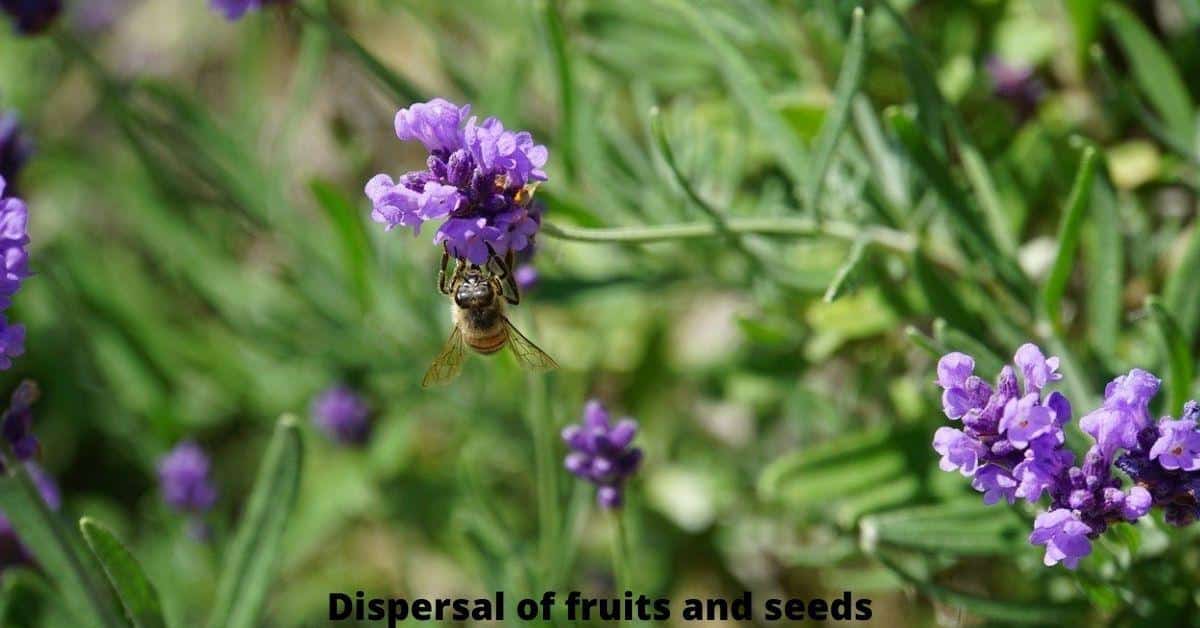Dispersal is the phenomenon of transferring Plant parts from one place to another. Dispersal of fruits and seeds are a very common feature in angiosperms which have great importance in their life process because of the following facts.
- If all the fruits and seeds fall under the parent plant, all may not be able to germinate to develop seedling.
- Sometimes seedlings will not get sufficient light and air, required for normal living.
- In many places, Soil nutrition will be insufficient for them as these have been mostly used up by the parent plant, and there will be sharing of the existing nutrition present in the soil.
- Development of the same group of seedlings, under the parent plant.
For these above facts, there will be the theory of the struggle for existence, thereby most of the seedlings will become very weak and liable to perish under such unfavourable conditions. Still, the natural hazards (floods, drought etc) may destroy the total plant population. Most of the plants depend on some external agents for their seed dispersal. In some plants, the fruits are provided with some explosive mechanism for achieving their goal.
Dispersal of fruits and seeds by the wind
Plants that require wind for their dispersal agent are called anemochorous types. For this wind dispersal, the seeds should be very light in weight, so that their lower buoyancy rate may help them to fly in the air for long distances. Following adaptation, the system helps to disperse seeds for long distances away from the mother plant.
Minute and light seeds
Seeds of some plants are very minute, dry and light in weight and are easily dispersed by the wind from one place to another, e.g. Orchids (one seed of orchid weight about 0.004mg), grains (fruits and seeds) of grasses etc (Fig 1.1 A).
Winged fruits and seeds
Different types of Wing-like structures develop on various types of fruits and seeds of some plants – these help them to float in the air.
- wings may develop from testa (seed coat) e.g. horseradish, Moringa olifera of Moringaceae (Fig 1.1B).
- wings may develop from persistent sepals e.g. Shorea robusta (Fig 1.1C) etc.
- also develop from the pericarp of fruit, e.g. Hiptage benghalensis of Malpighiaceae (Fig 1.1D) etc.
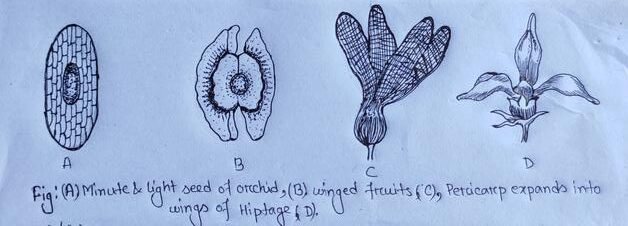
Parachute mechanism
some Appendage type structures develop on some fruits and seeds, which act as parachutes. By helping with this they remain in the air for a long time and can disperse for a long distance. The appendages are:
- Pappus: It is a modified structure of calyx, which turned into the small hair-like persistent structure, on the fruit, that is called Pappus that helps in the dispersal of fruits of many members of Asteraceae (Compositae), e.g. Vernonia cinera, Blumea lacera
- coma: These are tufts of hairy outgrown of testa developed at one or both ends of the seeds and helps to disperse for long-distance, e.g. seeds with one comma structure, Calotropis Procera of Asclepiadaceae, seeds with a double comma ( one each at both the ends), Alstonia scholaris of Apocynaceae.
- Hair outgrown on seeds: This type of structure is present all over the seeds as an outgrown of testa, e.g. Silk cotton, Bombax Ceiba of Bombacaceae.
- Persistent hairy style: The persistent hairy type structure are seen in the achene fruits, by the help of which fruits can float in the air and disperse for long-distance, e.g. Clematis gouriana, Naravelia zeylanica of Ranunculaceae.
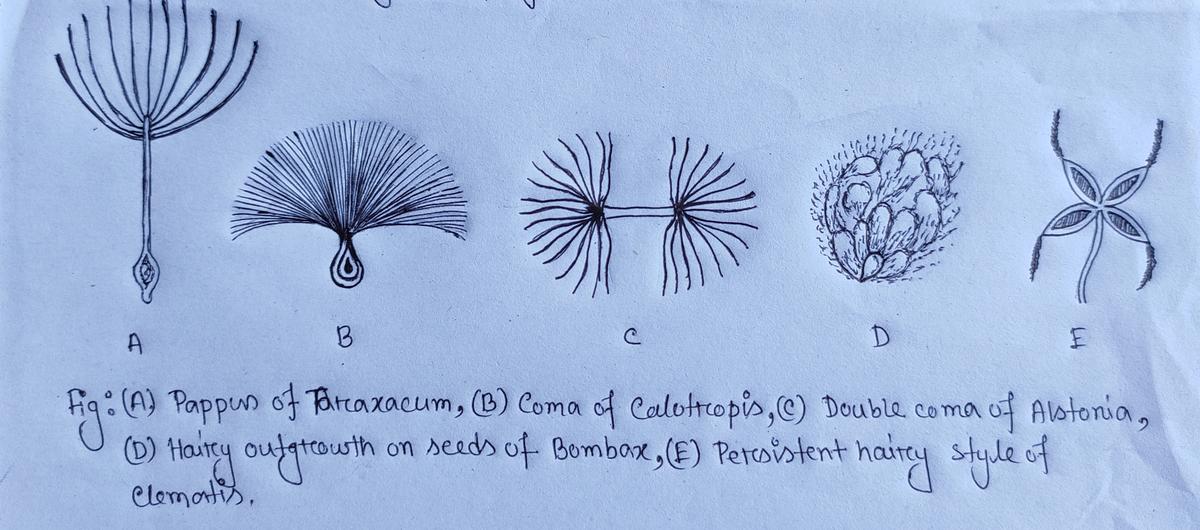
Censor mechanism
In this type of mechanism very small seeds are liberated slowly from the fruit through minute pores. e.g. Antirrhinum manus of Scrophulariaceae etc.
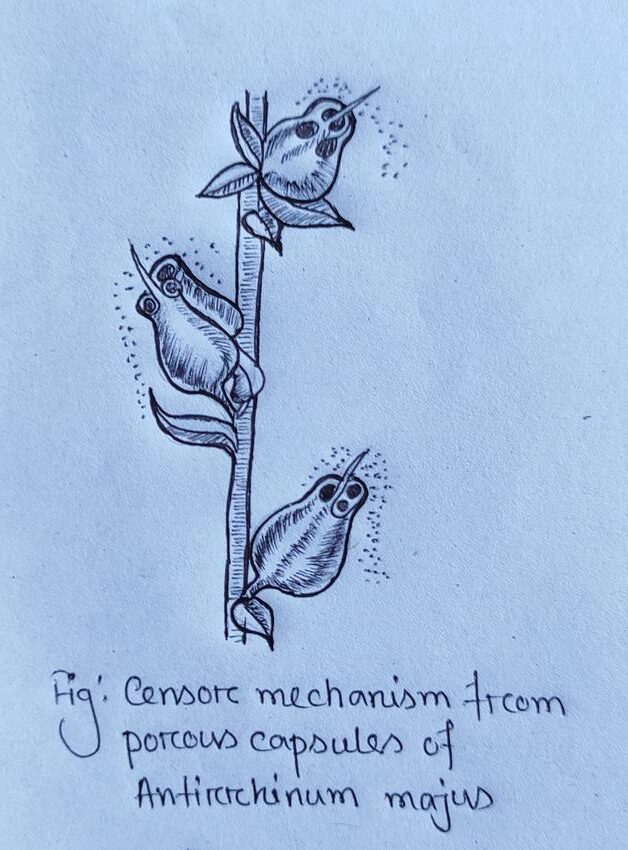
Dispersal of fruits and seeds by water
The plants growing on the bank of a river or sea-shore, disperse their seeds and fruits with the help of water current for a long distance. Floating devices in the form of fibrous or spongy water-proof coats present in these types of fruits and seeds. The plants which have required water as an agency for dispersal are called hypochlorous.
The fruitlets may lie embedded in the spongy thalamus because in this way they can be carried away to another by the help of water current,e.g. lotus, Nelumbo nucifera if Nymphaeaceae etc.
Dispersal of fruits and seeds by animals
The fruits and seeds with their adhering structures are dispersed by animals, such devices are called zoochorous.
Dry fruits and seeds –
Many dry fruits and seeds have spines, barbs, bars or sticky glands but means of which they can attach themselves to the body of animals or human beings and thus be transported to a distant place. Fruits may provide with:
- spines: The fruits provided with spines become attached to the body of human beings and animals, then they are dispersed to distant places, e.g. Achyranthus Aspera of Amaranthaceae.
- Hooked bars: fruits provided with many hooked bars attached to the body of animals including the clothes of human beings when passing through the plant population. e.g. spiny cocklebus, Xanthium strumarium of Asteraceae.
- Sticky glands: The fruits of some plants provided with sticky glands, they are dispersed to distant places e.g. Polanisia at Capparidaceae etc.
- Curved hairs: this type of structures may be attached to the animal body and are dispersed, e.g. Chrysopogon etc.
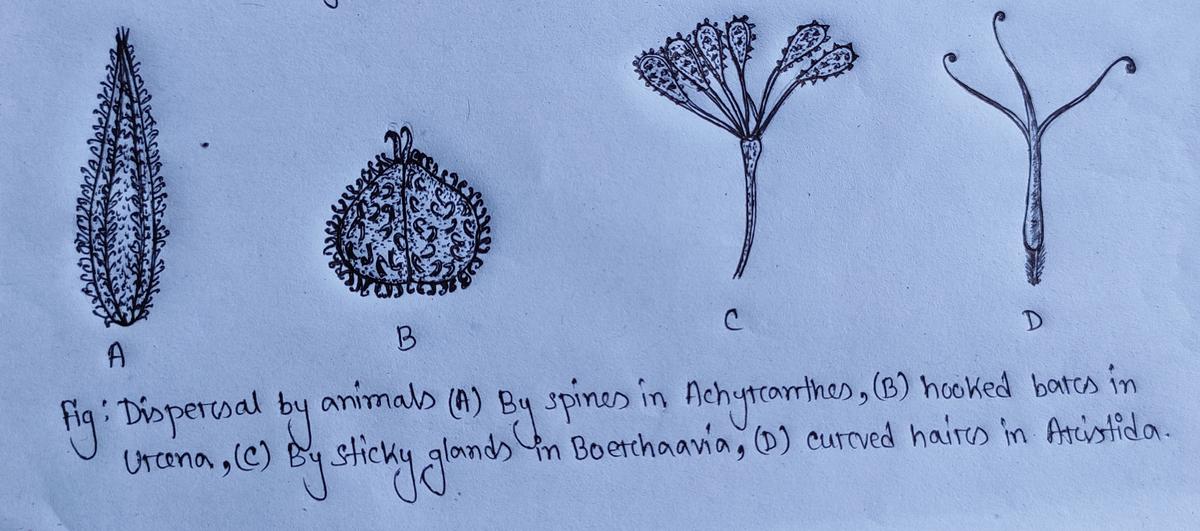
Fleshy fruits –
Fleshy fruits possess beautiful colour or test or both, inviting the animals especially the birds. These animals and birds disperse fruits and seeds in the following ways.
- The red colour of the fruit of banyan, Ficus benghalensis of Moraceae, attracts the birds like crow etc. After eating the fruits they flow away to other places. When the birds rub their beak to wipe off these seeds, the seeds are dispersed. Due to this, the planets are visible on the roof, temples in other places etc.
- In the case of Litchi chinensis of Sapindaceae, Mangifera indica of Anacardiaceae, fruits are collected by birds from the trees and then they fly away to distant places. After eating the sweet pulp of mango and other types of fleshy fruits, the seeds are left, thereby the seeds are dispersed.
- Seeds and fruits of some aquatic plants are dispersed from one pond to the other, getting attached to the legs of Aquatic birds like snipes, ducks etc.
- The fruits and seeds are also dispersed by human activity to their needed places.
Dispersal of fruits and seeds by explosive mechanism
In some cases, the pericarp of fruit – after ripening and drying – becomes stretched due to some external pressure in contact with air, water drops etc.
- In the case of, Andrographis paniculata, Ruellia tuberosa of Acanthaceae, mature fruits when in contact with moisture, suddenly burst with an explosive sound and the seeds are dispersed in the nearby regions.
- In the case of the mature fruits of Geranium palustre of Geraniaceae and balsam, Impatiens balsamina of Balsaminaceae, burst suddenly and the valves twist upwards, thereby seeds are dispersed.
- The mature fruits of a pea, Pisum sativum and many other plants of Fabaceae etc, suddenly burst into valves and the valves twist upwards. The seeds are then ejected with some force.
- Castor, Ricinus communis of Euphorbiaceae, when matured they normally break up elastically and the seeds are dispersed.
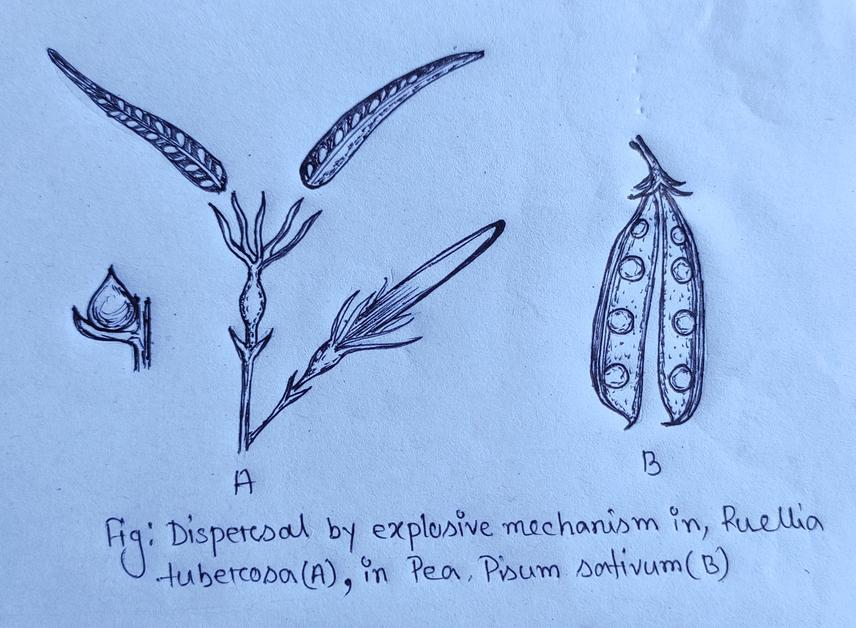
That’s it for this post. If you have any query please feel free to comment below. Thank you.
What is Dispersal of fruits?
Dispersal is the phenomenon of transferring Plant parts from one place to another.
what is anemochorous types of plant?
Plants that require wind for their dispersal agent are called anemochorous types.

